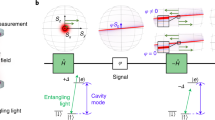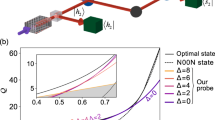Abstract
Much of modern metrology and communication technology encodes information in electromagnetic waves, typically as an amplitude or phase. Although current hardware can perform near-ideal measurements of photon number or field amplitude, the ability to perform an ideal phase measurement is still lacking, even in principle. In this work, we implement a single-shot canonical phase measurement on a one-photon wave packet, which surpasses the current standard of heterodyne detection and is optimal for single-shot phase estimation. By applying quantum feedback to a Josephson parametric amplifier, our system adaptively changes its measurement basis during photon arrival and allows us to validate the detector’s performance by tracking the quantum state of the photon source. These results demonstrate that quantum feedback can both enhance the precision of a detector and enable it to measure new classes of physical observables.
This is a preview of subscription content, access via your institution
Access options
Access Nature and 54 other Nature Portfolio journals
Get Nature+, our best-value online-access subscription
$29.99 / 30 days
cancel any time
Subscribe to this journal
Receive 12 print issues and online access
$209.00 per year
only $17.42 per issue
Buy this article
- Purchase on Springer Link
- Instant access to full article PDF
Prices may be subject to local taxes which are calculated during checkout




Similar content being viewed by others
Data availability
Source data are available for this paper. All other data that support the plots within this paper and other findings of this study are available from the corresponding author on reasonable request.
References
Busch, P., Lahti, P., Pellonpaa, J.-P. & Ylinen, K. Are number and phase complementary observables? J. Phys. A 34, 5923 (2001).
London, F. Über die Jacobischen transformationen der quantenmechanik. Z. Phys. 37, 915 (1926).
Susskind, L. & Glogower, J. Quantum mechanical phase and time operator. Phys. Phys. Fiz. 1, 49 (1964).
Yonezawa, H. et al. Quantum-enhanced optical-phase tracking. Science 337, 1514–1517 (2012).
Wheatley, T. et al. Adaptive optical phase estimation using time-symmetric quantum smoothing. Phys. Rev. Lett. 104, 093601 (2010).
Armen, M. A., Au, J. K., Stockton, J. K., Doherty, A. C. & Mabuchi, H. Adaptive homodyne measurement of optical phase. Phys. Rev. Lett. 89, 133602 (2002).
Iwasawa, K. et al. Quantum-limited mirror-motion estimation. Phys. Rev. Lett. 111, 163602 (2013).
Wiseman, H. M. Adaptive phase measurements of optical modes: going beyond the marginal Q distribution. Phys. Rev. Lett. 75, 4587 (1995).
Koch, J. et al. Charge-insensitive qubit design derived from the cooper pair box. Phys. Rev. A 76, 042319 (2007).
Murch, K. et al. Cavity-assisted quantum bath engineering. Phys. Rev. Lett. 109, 183602 (2012).
Pozza, N. D., Wiseman, H. M. & Huntington, E. H. Deterministic preparation of superpositions of vacuum plus one photon by adaptive homodyne detection: experimental considerations. New J. Phys. 17, 013047 (2015).
Castellanos-Beltran, M., Irwin, K., Hilton, G., Vale, L. & Lehnert, K. Amplification and squeezing of quantum noise with a tunable Josephson metamaterial. Nat. Phys. 4, 929–931 (2008).
Macklin, C. et al. A near-quantum-limited Josephson traveling-wave parametric amplifier. Science 350, 307–310 (2015).
Murch, K. W., Weber, S. J., Macklin, C. & Siddiqi, I. Observing single quantum trajectories of a superconducting quantum bit. Nature 502, 211–214 (2013).
Campagne-Ibarcq, P. et al. Observing quantum state diffusion by heterodyne detection of fluorescence. Phys. Rev. X 6, 011002 (2016).
Wiseman, H. & Killip, R. Adaptive single-shot phase measurements: a semiclassical approach. Phys. Rev. A 56, 944 (1997).
Eddins, A. et al. High-efficiency measurement of an artificial atom embedded in a parametric amplifier. Phys. Rev. X 9, 011004 (2019).
Kerckhoff, J., Lalumière, K., Chapman, B. J., Blais, A. & Lehnert, K. On-chip superconducting microwave circulator from synthetic rotation. Phys. Rev. Appl. 4, 034002 (2015).
Sarovar, M. & Whaley, K. B. Adaptive homodyne phase discrimination and qubit measurement. Phys. Rev. A 76, 052316 (2007).
Grimsmo, A. L., Combes, J. & Baragiola, B. Q. Quantum computing with rotation-symmetric bosonic codes. Phys. Rev. X 10, 011058 (2020).
Oreshkov, O. & Brun, T. A. Weak measurements are universal. Phys. Rev. Lett. 95, 110409 (2005).
Acknowledgements
We thank E. Flurin, J.M. Kreikebaum and V.V. Ramasesh for assistance, and MIT Lincoln labs for fabrication of the travelling wave parametric amplifier. This work was supported by the Army Research Office under Grant Number W911NF15-1-0496. L.S.M. was supported by National Science Foundation Grant Number 1106400 and the Berkeley Fellowship for Graduate Study.
Author information
Authors and Affiliations
Contributions
L.S.M. and H.M.W. conceived of the experiment with assistance from S.H.-G. L.S.M., S.H.-G. and W.P.L. constructed the experiment. S.H.-G. fabricated the qubit and Josephson parametric amplifier, and W.P.L. programmed the FPGA. L.S.M. and W.P.L. conducted the experiment. L.S.M. analysed the data and wrote the manuscript with assistance from W.P.L. All work was carried out under the supervision of H.M.W. and I.S.
Corresponding author
Ethics declarations
Competing interests
The authors declare no competing interests.
Additional information
Peer review information Nature Physics thanks Naoki Yamamoto and the other, anonymous, reviewer(s) for their contribution to the peer review of this work.
Publisher’s note Springer Nature remains neutral with regard to jurisdictional claims in published maps and institutional affiliations.
Supplementary information
Supplementary Information
Supplementary information and Figs. 1–6.
Source data
Source Data Fig. 1
x and y axes of Fig. 1c.
Source Data Fig. 3
x and y axes of Fig. 3b, histogram data of Fig. 3d.
Source Data Fig. 4
Histogram data (x and y axes) for Fig. 4a and Fig. 4c.
Rights and permissions
About this article
Cite this article
Martin, L.S., Livingston, W.P., Hacohen-Gourgy, S. et al. Implementation of a canonical phase measurement with quantum feedback. Nat. Phys. 16, 1046–1049 (2020). https://doi.org/10.1038/s41567-020-0939-0
Received:
Accepted:
Published:
Issue Date:
DOI: https://doi.org/10.1038/s41567-020-0939-0
This article is cited by
-
Determination of the asymptotic limits of adaptive photon counting measurements for coherent-state optical phase estimation
npj Quantum Information (2022)
-
Engineered dissipation for quantum information science
Nature Reviews Physics (2022)
-
Heterodyne sensing of microwaves with a quantum sensor
Nature Communications (2021)



